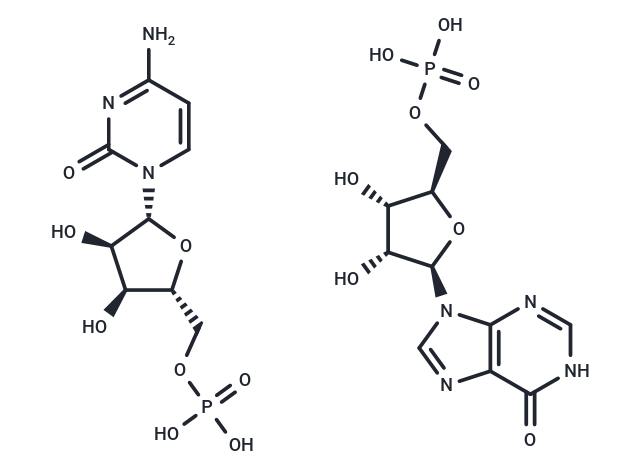Shopping Cart
- Remove All
 Your shopping cart is currently empty
Your shopping cart is currently empty

Polyinosinic-polycytidylic acid (Poly(I:C)) is a double-stranded RNA (dsRNA) and a TLR3 agonist. Polyinosinic-polycytidylic acid induces natural immunity in mammals.

| Pack Size | Price | Availability | Quantity |
|---|---|---|---|
| 5 mg | $45 | In Stock | |
| 10 mg | $72 | In Stock | |
| 25 mg | $148 | In Stock | |
| 50 mg | $283 | In Stock | |
| 100 mg | $439 | In Stock | |
| 500 mg | $987 | In Stock |
| Description | Polyinosinic-polycytidylic acid (Poly(I:C)) is a double-stranded RNA (dsRNA) and a TLR3 agonist. Polyinosinic-polycytidylic acid induces natural immunity in mammals. |
| In vitro | METHODS: Cervical cancer cells HeLa, SiHa, C33A and lung cancer cells A549 were treated with polyinosinic-polycytidylic acid (0.1-1 μg/mL) for 24 h, and cell death was detected using PI Staining. RESULTS: Polyinosinic-polycytidylic acid effectively induced tumor cell death in a dose-dependent pattern. [1] METHODS: Rat astrocytes were pretreated with polyinosinic-polycytidylic acid (10-20 μg/mL) for 12 h, and then exposed to oxygen-glucose deprivation (OGD) for 12 h. The morphology of the cells was examined by microscopy. RESULTS: OGD induced significant cellular damage, and the cells appeared to be healthier in the group pretreated with polyinosinic-polycytidylic acid.Polyinosinic-polycytidylic acid exerted a certain degree of protective effect against OGD-induced damage in cultured astrocytes. [2] |
| In vivo | METHODS: To investigate the neuroprotective effects in an acute ischemia model, Polyinosinic-polycytidylic acid (0.3 mg/kg) was administered as a single intramuscular injection to Kun-Ming strain mice, and a model of arterial occlusion (MCAO) was constructed 2 h later. RESULTS: Administration of polyinosinic-polycytidylic acid significantly attenuated neurological deficits in the ischemic striatum and cortex, reduced infarct volume, and suppressed the elevation of TNFα and IL-6 levels. [2] METHODS: To test the antitumor activity in vivo, Polyinosinic-polycytidylic acid (1-100 μg/mouse) was intraperitoneally injected into a mouse model of metastatic tumors C57BL/6J induced by cutaneous melanoma B16-F10. RESULTS: Lung tumor growth stopped after a single dose of Polyinosinic-polycytidylic acid. Polyinosinic-polycytidylic acid has potential antitumor activity in an established mouse model of lung metastasis. [3] |
| Alias | Poly(I:C) |
| Formula | (C10H13N4O8P)x.(C9H14N3O8P)x |
| Cas No. | 24939-03-5 |
| Smiles | Nc1ccn([C@@H]2O[C@H](COP(O)(O)=O)[C@@H](O)[C@H]2O)c(=O)n1.O[C@@H]1[C@@H](COP(O)(O)=O)O[C@H]([C@@H]1O)n1cnc2c1nc[nH]c2=O |
| Relative Density. | no data available |
| Storage | store at low temperature,store under nitrogen | Powder: -20°C for 3 years | In solvent: -80°C for 1 year | Shipping with blue ice. |
| Solubility Information | H2O: 100 mg/mL, Sonication is recommended. DMSO: < 1 mg/mL (insoluble or slightly soluble) |

Copyright © 2015-2024 TargetMol Chemicals Inc. All Rights Reserved.